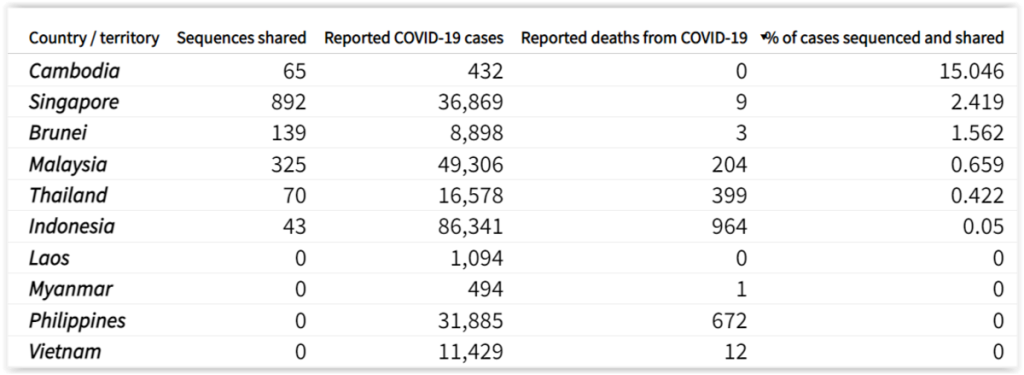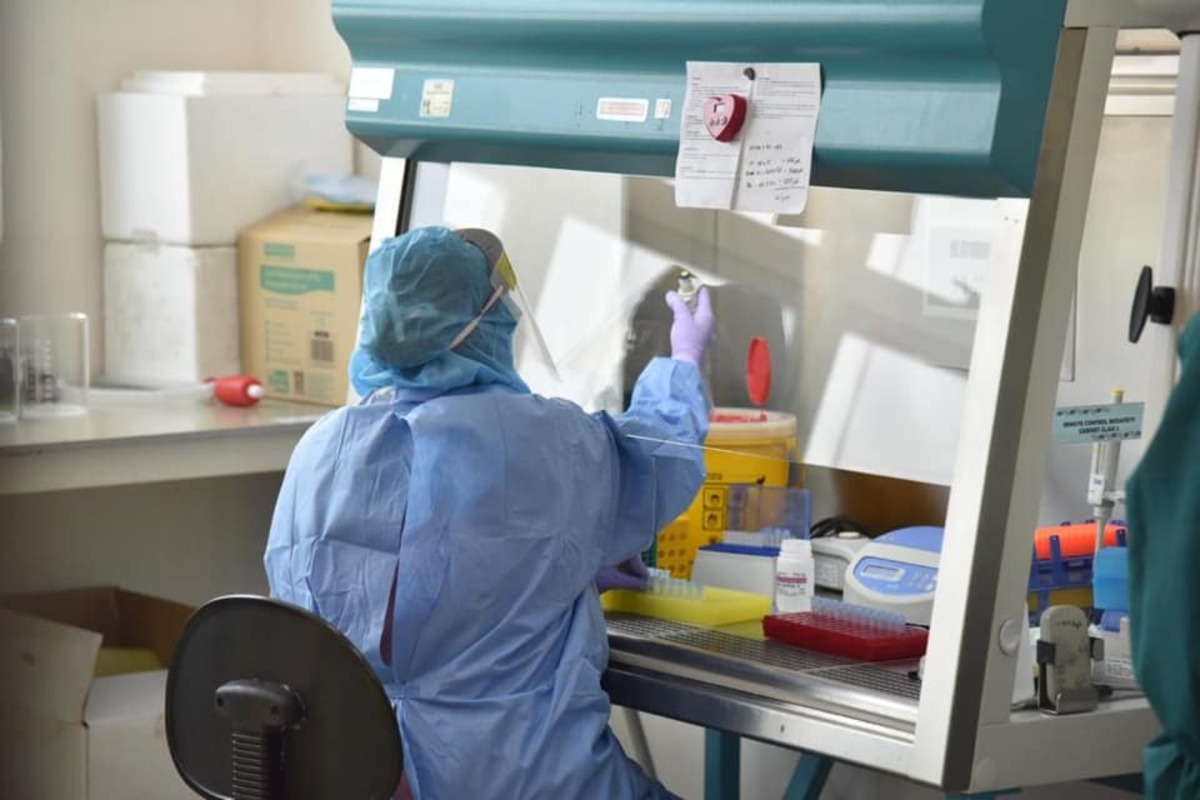KUALA LUMPUR, Jan 3 – Malaysia sequenced and shared 0.659 per cent of Covid-19 cases in the last 30 days, 3.7 times lower than Singapore that conducted virus genome sequencing for 2.419 per cent of its cases.
According to global virus tracker database Gisaid, as accessed by CodeBlue yesterday, Cambodia topped SARS-CoV-2 virus genome sequencing and sharing in the Asean region in the last 30 days, in terms of percentage of reported Covid-19 cases, at 15.046 per cent, followed by Singapore (2.419 per cent), Brunei (1.562 per cent), Malaysia (0.659 per cent), Thailand (0.422 per cent), and Indonesia (0.05 per cent).
Laos, Myanmar, the Philippines, and Vietnam did not conduct and share any SARS-CoV-2 genome sequencing in the past month.
In terms of absolute figures, over the last 30 days, Malaysia shared 325 sequences of the SARS-CoV-2 virus that causes Covid-19, second highest in Asean behind Singapore’s 892 sequences.
Cambodia was fifth highest with 65 sequences shared, but it topped the region in terms of percentage of Covid cases sequenced at over 15 per cent because the country only reported 432 Covid-19 cases in the last 30 days, compared to 49,306 in Malaysia and 36,869 in Singapore.

Globally, Iceland sequenced and shared the highest percentage of reported Covid-19 cases at 37.361 per cent of 902 cases in the last 30 days, or 337 sequences shared.
Second highest was Denmark at 27.44 per cent of 31,629 reported Covid-19 cases, or 8,679 sequences shared.
Cambodia’s 15 per cent of Covid cases sequenced and shared was the third highest virus genome sequencing rate in the world over the past month.
The United States shared 26,458 SARS-CoV-2 sequences in the last 30 days, highest globally in terms of absolute figures, comprising 1.319 per cent of 2,005,923 reported Covid-19 cases.
The United Kingdom sequenced and shared 7.259 per cent of 138,041 reported Covid-19 cases in the same period, or 10,020 sequences, second highest globally in terms of absolute figures.
China, which is facing a huge Covid-19 wave, sequenced and shared just 0.059 per cent of 644,671 reported cases over the last 30 days, or 380 sequences.
The World Health Organization (WHO), after meeting with high-level health Chinese officials last December 30, issued a statement urging China to share data on its Covid epidemiological situation, including more genetic sequencing data, to help China and other countries form accurate risk assessments and to inform effective responses.
According to WHO’s Covid-19 dashboard, Covid-19 infections are on the rise in Europe, the Americas, and the Western Pacific. Malaysia is classified under the WHO’s Western Pacific region.
XBB Dominant Variant In Malaysia Since Oct 2022
Health director-general Dr Noor Hisham Abdullah reported yesterday that XBB has been the dominant Covid-19 variant in Malaysia since last October.
XBB comprised 55.4 per cent of samples that were sequenced last December, followed by BA.2.75 (20.8 per cent) and BQ.1 (10.8 per cent).
“Both the XBB and B.2.75 variants are among the lineages under monitoring by WHO (World Health Organization),” he said.
Five Omicron sublineages are categorised as lineage under monitoring (LUM) by the WHO – BA.5, BA.2.75, BA.4.6, XBB, dan BA.2.3.20 – all of which have been detected in Malaysia in varying degrees.
“Meanwhile, in China, the BA.5.2 and BF.7 variants comprise about 80 per cent of the variants currently circulating in the country at this time. Both of these variants are sub-lineages of Omicron BA.5 and have yet to be categorised as lineage under monitoring by the WHO,” said Dr Noor Hisham.
“However, both the BA.5.2 and BF.7 variants are believed to be able to cause reinfection or to have higher infection rates due to the high number of cases in China.”
The Health DG said both the BA.5.2 and BF.7 variants have also been detected in Malaysia. As of last December 31, health authorities detected 4,148 BA.5.2 cases and three BF.7 cases.
“However, there is not yet data linking more severe disease or deaths with the BA.5.2 and BF.1 variants.”
Malaysia’s Imported Covid Cases Rose 129.6% In 52nd Epid Week/ 2022
According to the Health DG, imported new Covid-19 cases increased by 129.6 per cent from 14 cases in the 51st epidemiological week of 2022 starting December 18 to 32 cases in the 52nd epid week of last year starting December 25.
Local new Covid-19 cases declined by 36.5 per cent in the same period from 5,880 to 3,735 cases.
Overall, new reported Covid-19 cases nationwide declined by 36.1 per cent, from 5,894 confirmed infections in the 51st epid week to 3,767 in the 52nd week.
Dr Noor Hisham said Malaysia has conducted wastewater surveillance for Covid-19 since June 2022 on samples from international entry points and 15 sentinel points representing each state in Malaysia to identify the presence of the SARS-CoV-2 virus in the waste water, trends on concentration of the virus, and variants in the community.
In that period until December 31 last year, 330 wastewater samples were tested, comprising 29 from international entry points and 301 from sentinel locations. Twenty-eight of the 29 samples from international entry points (96.5 per cent) showed the presence of Omicron, while one is still being tested. Fifteen of the 28 samples showed that the dominant sublineages were BA.5, BA.2, BA.2.75, and BA.2.12.
About 95.7 per cent, or 288 of 301 wastewater samples from sentinel locations, were positive for Covid-19, all Omicron. Three samples did not show SARS-CoV-2, while 10 are still being tested. Of the 288 positive samples, 32 (or 11.1 per cent) have completed whole genome sequencing, showing the BA.5, BA.2, BA.2.75, and BA.2.12 variants.
China’s decision to reopen international borders from January 8, amid anecdotal reports of a huge surge of coronavirus infections and deaths, has triggered travel restrictions by multiple countries — including the UK, US, South Korea, and France — that imposed pre-departure test requirements on visitors coming from China. Morocco has banned the entry of all travellers from China.
Malaysia has yet to mandate Covid-19 testing rules for China arrivals. In a statement yesterday, Health Minister Dr Zaliha Mustafa simply said that her decision to extend the “infected local areas” declaration for all states and federal territories in Malaysia under the Prevention and Control of Infectious Diseases Act 1988 (Act 342) to June 30 this year would enable the government to implement border control measures like health checks at the country’s entry points.
“This will be implemented if necessary, not only on visitors or travellers (Malaysian citizens and non-citizens) coming from China, but arriving from all countries around the world,” she said.
The health minister also said, without elaborating further, that MOH was always “prepared to increase health care capacity to face any possibility”.
CodeBlue previously reported that both public and private hospitals are now full of non-Covid cases, causing patients to be stranded for days in the emergency department of major public hospitals.
The Association of Private Hospitals Malaysia said recently that private hospitals would not be able to help public hospitals as patients are waiting for up to six to eight hours or longer in the emergency rooms of private hospitals, due to insufficient beds in wards caused by a dire shortage of nurses.








